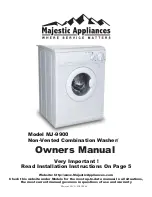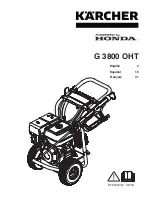
Washing Machine /User’s Manual
31 / EN
6
Maintenance and cleaning
Service life of product extends and frequently
experienced problems will be reduced if it is
cleaned at regular intervals.
6.1 Cleaning the detergent drawer
Clean the detergent drawer at regular intervals
(every 4-5 washing cycles) as shown below
in order to prevent accumulation of powder
detergent in time.
Lift the rear part of the siphon to remove it as
illustrated.
C
If water and softener more than a normal
amount start to accumulate on the
softener compartment, perform siphon
cleaning.
2. Wash the detergent drawer and the siphon with
plenty of lukewarm water in a washbasin. In
order to prevent the residues to contact your
skin, clean it with an appropriate brush by
wearing a pair of gloves.
3 After cleaning, replace the siphon back to its
seating and push its front section downwards to
make sure that the locking tab engages.
6.2 Cleaning the loading
door and the drum
For products with drum cleaning programme,
please see Operating the product - Programmes.
For products without drum cleaning, follow the
below steps
to clean the drum:
Select
Additional Water
or
Extra Rinse
auxiliary
functions. Use a Cottons
programme
without
pre-wash. Set
the temperature to the level
recommended on the drum cleaning agent
which can be provided from authorized
services
. Apply this procedure
without any
laundry in the product.
Before starting the
programme, put 1 pouch of special drum cleaning
agent (if the special agent could not be supplied,
put max. 100 g of powder anti-limescale) into the
main wash detergent compartment (compartment
no. „2“). If the anti-limescale is in tablet form, put
only one tablet into the main wash compartment
no. „2“. Dry the inside of the bellow with a clean
piece of cloth after the programme has come to
an end.
C
Repeat the drum cleaning work at every
2 months.
Use an anti-limescale suitable for the
washing machines.
Check and make sure that there is not any foreign
bodies left inside the drum after each wash.
If the holes in the bellows shown in the Figure are
clogged, open the holes by means of a toothpick.
C
Rust stains may form inside the drum
due to the metal objects. Clean the stains
on the surface of the boiler with stainless
steel cleaning agents. Never use steel
wool or wire wool.
A
CAUTION:
Never use sponge or scrub
materials. These will damage the painted
and plastic surfaces.
6.3 Cleaning the body
and control panel
Wipe the body of the machine with soapy water or
non-corrosive mild gel detergents as necessary,
and dry with a soft cloth.
Use only a soft and damp cloth to clean the
control panel.
6.4 Cleaning the water intake filters
There is a filter at the end of each water intake
valve at the rear of the machine and also at the
end of each water intake hose where they are
connected to the tap. These filters prevent the
foreign substances and dirt in the supply water to










































